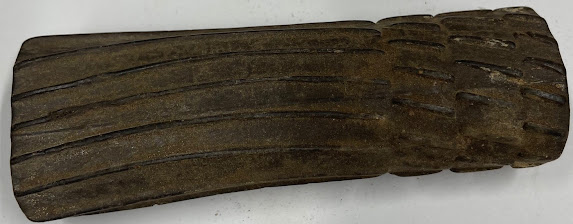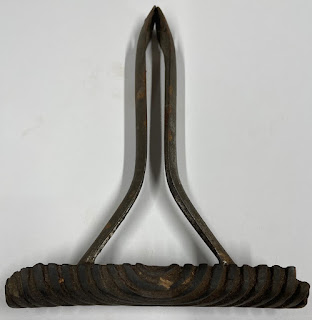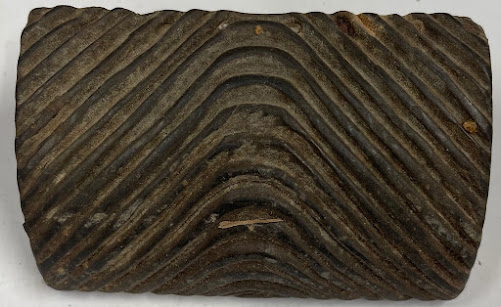I was fortunate enough to come across a tattered, barn fresh, faux-leather bag that had clearly been the home of a mouse family. Despite the rough appearance, I immediately knew that this collection of odd pieces was actually a craftsman's bag of specialized tools. It is a wonderfully complete toolkit for the process of "graining" wood.
Graining is how the frugal craftsman or homeowner could turn a plain board into something resembling a much higher quality timber. Its unclear who the craftsman was or how extensive his work really was but the combination of homemade and commercially available tools demonstrate that he took it seriously. The tattered newspaper remains from the Sioux City Journal were dated 1932 and the tools came from a seller in Spencer, Iowa.
As it relates to the purpose of my website, guitars and other musical instruments were also subject to faux finishes to replicate more expensive wood.
History
Graining is not a new practice as Nancy McClelland explained in her 1926 article "The Revival of Wood-Graining" in Volume 49 of House & Garden. She notes that the practice of simulating wood with paint gained popularity in 17th century England and by the 18th century was common practice to make rooms seem more welcoming. She also explains that the French Revolution led to a shortage of English oak which led to an even higher interest in the art of wood graining until it ceased to be popular later that century. At the time of her writing, imitation materials were en vogue as celluloid plastic had been introduced at the turn of the century and replica ivory, pearl, and shell were being fashioned into cheap, everyday items.
The art of graining would require knowledge of both contemporary art practices as well as familiarity with different species of wood and their grain. Miss McClelland tells a story of a Scotch painter who apprenticed as a boy in the art of graining. His training began with two doors; one mahogany and the other plain. He was tasked with painting the plain door to match the mahogany exactly. After completing the work the mahogany door was taken away and he was told to paint it again from memory. The process was repeated with other species until the grain, color, and peculiarities of each timber were well ingrained in the artist's mind [1].
 |
| A homemade wood grainer from Popular Mechanics c.1923 Image Source: Google Books |
If you owned a subscription to a trade or home improvement periodical during the era, its likely you would've found resources on how to perform your own graining.
Irreplaceable Literature
"House-Painting, Carriage-Painting, and Graining" by John W. Masury (pub. 1881) is a probably the best resource I have found in terms of explaining tools and the various colors needed to mimic rosewoods, mahogany, oak, etc. It is completely free to read on Google Books and the information can be found on Page 113 or the beginning of Chapter XII.
"Cassell's House Decoration - A Practical Guide to Painters' and Decorators' Work" by Cassell and Co. (pub. 1913) is another great resource and includes more color combinations as well as photographs of various techniques to match all variety of oak, walnut, ash, birdseye maple, etc. It is also completely free on Google Books and begins on Page 222.
Interesting Patents
1898 - J. J. Callow - https://patents.google.com/patent/US605244A/en?oq=us+605244a
1908 - Charles T. Ridgely - https://patents.google.com/patent/US944821A/
1908 - Charles T. Ridgely - https://patents.google.com/patent/US930690A/
1913 - Thomas J Mcelhenie of the Ohio Varnish Co - https://patents.google.com/patent/US1121272A/
1914 - George C. Powers - https://patents.google.com/patent/US1123590A/
Gallery of Tools
 |
| A variety of steel toothed graining combs in different widths and tooth count |
 |
| These two handmade combs are made of poplar with flexible plastic teeth |
 |
| These tools have leather faces with grooves cut into them and twine to attach them to the wooden handle |

 |
| This large rubber pad is clearly designed to mimic the medullary rays of quartersawn oak Stamped "J J Callow PAT June 7 90 Cleveland Ohio" US Patent: US605244A |
 |
| Rubber rollers with a molded "bulls-eye" pattern |
 |
| They have become deformed and hard with age but I suspect they would've slid on a paint roller for covering large areas |

 |
| An interesting 'interrupted' pattern here |

| ||
These half-round blocks have a rubber pattern nailed onto them and two tapered holes on adjacent sides that each fit the wooden handle |
  |
| These tools have bent metal handles, rubber pads, and were definitely commercially produced |
 |
| Stamped "PAT. June 6 98" |
 |
| This 'check' or 'over-combing' roller is made out of wood with a bent metal handle |
 |
| This large pad is very similar to the most common grainers available today You drag it through the paint and change the angle to form the grain lines |
Sources
[1] https://www.google.com/books/edition/House_Garden/NSIgAQAAMAAJ?hl=en&gbpv=0














No comments: